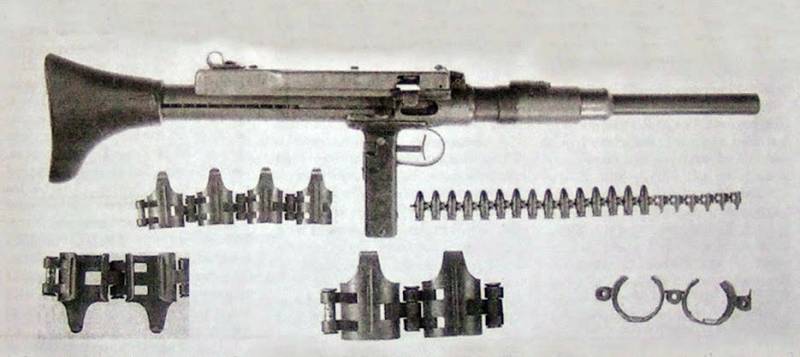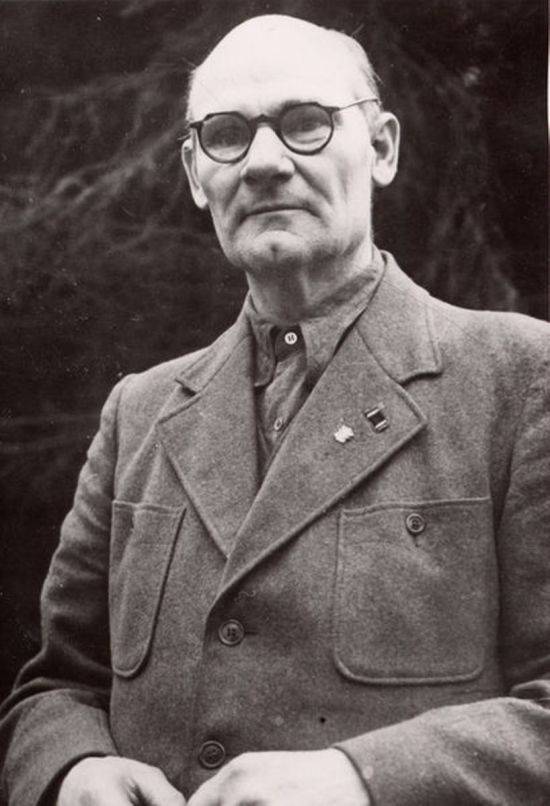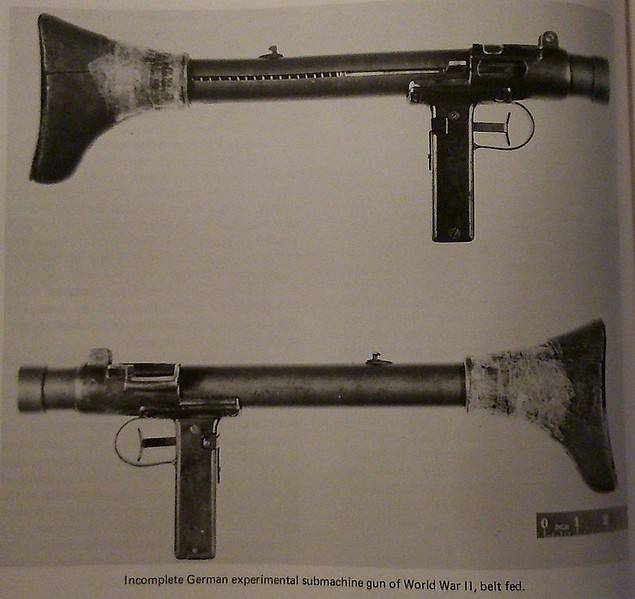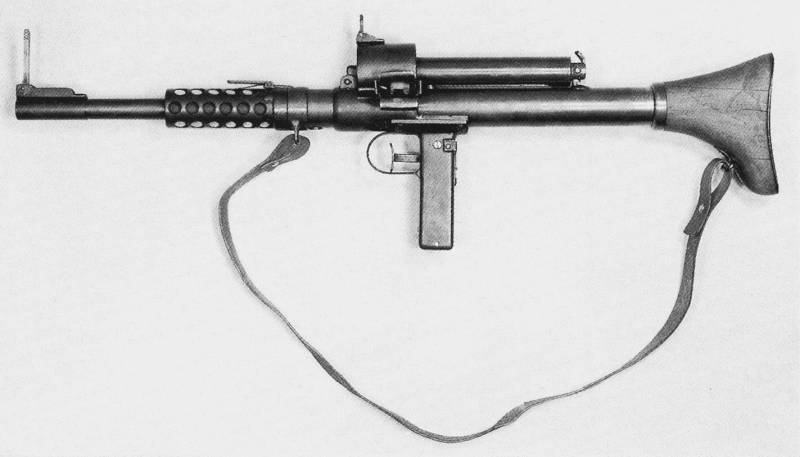A machine gun pistol with a tape feed design A. Coders (Germany)
Immediately it should be noted that the biography and the results of the activities of the German gunsmith A. Coenders in the postwar years were unfairly forgotten, and are now known only to a narrow circle of specialists. Nevertheless, for several decades of work in various organizations, an engineer of Dutch origin managed to take part in the development of a number of models of small arms and artillery, including those that had received certain fame. However, later the designer was forgotten, and historians had to literally conduct an investigation and establish his involvement in certain projects.

Submachine gun A. Coenders. Apparently, an early prototype. Next to the weapon are tape links. Photo Strangernn.livejournal.com
About 20 years ago, American historians of small arms found a strange specimen at one of the auctions. It was an experimental German-made submachine gun, which differed from its counterparts in the ammunition used and the method of supplying ammunition. Any information about the origin of this product was missing. Moreover, there was no marking on the product. As a result, some assumptions appeared, most of which were eventually found to be erroneous.
Initially it was assumed that an unusual weapon was created and manufactured by one of the leading German enterprises, and after the war, in one way or another, fell into the United States. However, the developer could not be established, since there was no mention of such a project in well-known documents. In this case, the most likely version was considered according to which the submachine gun was made by Erfurter Maschinenfabrik (ERMA Werke).
Later, new information about unusual weapons. Former German engineer Heinz-Kurt Schmidt published photographs of several experimental samples, including a machine gun with a tape ammunition. According to his information, all these products were designed in the early forties by the gunsmith August Coders, who at that time worked at Röchling'sche Eisen und Stahlwerke. Sam H.-K. Schmidt at that time was an assistant designer. He also announced some technical details of the project.
As far as is known, the real authors of the submachine gun did not use any particular name for their project. At the same time, the A. Koenders submachine gun - according to the results of the old incorrect assumption - is often called the ERMA Gurt Model 1944 (“ERMA, tape, model 1944,”). Naturally, this name appeared relatively recently and has no relation to the real model.
According to the available information, A. Koenders and his colleagues began to develop a new submachine gun no earlier than 1940 of the year. Their goal was to create a new weapon under the standard pistol cartridge 9x19 mm "Parabellum". According to others, the weapon was supposed to use an intermediate ammunition 7,92x33 mm, delivered to the series in 1942 year. Certain features of the weapon suggest that information about the intermediate cartridge does not correspond to reality.
Apparently, a promising model should have been distinguished by simplicity of design with high combat qualities. This may explain the characteristic appearance and technical appearance of the product, as well as the use of tape power. Unlike box magazines that are traditional for such weapons, the tape made it possible to increase ammunition without serious technological limitations, which also simplified the production of weapons to a certain extent.

Augustus Coenders. Photo Shotguncollector.com
The main element of the submachine gun was a long tubular receiver. In its front part there were fastenings for mounting a rifled barrel, behind which there was a movable shutter. The entire rear part of the tube was given for the installation of a reciprocating combat spring and for moving the bolt. An interesting feature of the receiver was the casing at the top. It was proposed to place the device for working with cartridge belt. The rear end of the receiver was closed by a removable lid, made integral with a large shoulder rest.
It is known about the existence of at least two prototypes that had certain differences. So, one of them was equipped with a U-shaped casing of the ammunition system, while a cylindrical unit was installed on the second. The second was also equipped with a small perforated barrel casing and other sights. There is reason to believe that the first submachine gun, which was notable for its simplicity of design, was made to test the main provisions of the project. Subsequently, on the basis of the available developments, a second prototype was made.
Both prototypes had a similar design of internal units. Used automation based on the free shutter. The mass of the shutter and the power of the recoil-fighting springs were selected taking into account obtaining the maximum possible rate of fire. Also, this design allowed to slow the bolt before the impact in the rearmost position. How exactly the ignition of the primer was realized is unknown. Most likely, the shutter had a fixed drummer. On the right side of the bolt, a small cocking handle was attached. While the weapon was in operation, it had to move along the long slot of the receiver.
The submachine gun was completed with an uncomplicated firing mechanism, part of which was located in the hollow pistol grip. On the front edge of the last there was a semicircular protruding trigger guard. The specific placement of the trigger led to the fact that the trigger does not swing on the horizontal axis, but moved along the receiver. Its displacement led to the release of the shutter and shot. The safety of the weapon was ensured by an uncomplicated safety lock that blocked the movement of the bolt.
Perhaps the most interesting part of the A. Koenders submachine gun was the ammunition supply system. The designer decided to abandon the traditional store supply for such weapons and use tape. Cartridges were proposed to be stored in non-bulk metal tape. At that time, the weapon under the pistol cartridge “Parabellum” with belt power was not produced serially, which is why the German designers had to independently develop new links.
In preparation for the shooting tape was placed in the receiving window on the left side of the weapon. The empty part of the tape when shooting was displayed to the right, through the window above the opening of the ejection of spent cartridges. Work with cartridges in the tape was assigned to an uncomplicated system of rods connected to the bolt. When the bolt moved backwards, a new cartridge was pulled out of the tape and dropped on the discharging line. Then the belt was pulled with a new cartridge inlet to the exhaust device. From the point of view of other reloading operations, the weapon did not differ from other systems of its class.
Devices for working with the tape were made in the form of a removable unit and installed on simple fixings. During incomplete disassembly, the cover with all rods could be removed from the receiver and serviced separately.
An experienced submachine gun of simplified design received an open mechanical sight, which made it possible to obtain acceptable test accuracy. The sight itself was on the back of the casing of the ammunition systems. A small fly was placed near the front wall of the casing. A more sophisticated next prototype had other means of aiming. Now the sight was placed in the front of the upper casing. The fly was performed swinging and fixed on the influx in the muzzle of the trunk. According to some reports, it could be folded, which allowed the use of weapons with embrasures armored vehicles or fortifications.
Both versions of the submachine gun differed specific ergonomics. Hold the weapon should be using a vertical pistol grip with a trigger. In the back of the receiver was placed wooden shoulder rest. At the same time, holding the weapon with two hands was a difficult task: the barrel cover could heat up and threaten with burns, while the grip on the receiver was not very convenient.
The original weapon was of medium size. Despite the impossibility of folding and downsizing, the Coenders submachine gun was almost the same as the German serial products of that time. At the same time, it was a bit heavier: the increased mass was due to the presence of a long metal receiver and the characteristics of the bolt. The rate of prototypes, according to some, reached 900-1000 rounds per minute - significantly more than the army 38 / 40 MPs.
Not earlier than 1940 of the year, August Coenders and his colleagues produced at least two prototypes of a promising submachine gun, differing in some design features. The characteristic appearance and some of the damage seen in the surviving photographs indicate a series of tests, not only with shooting. It can be assumed that the weapon was able to confirm the stated characteristics.
Nevertheless, for one reason or another, the submachine gun of A. Koders did not go into the series. Why this development is not interested in the German command - is unknown. You can make various assumptions, but the true reasons are unlikely to be established. However, regardless of the justification of the refusal, the weapon did not fit into the series and did not become the standard armament of the army.
It is worth noting that the design of A. Koders had not too many positive features and clear advantages over the serial MP 38 / 40. The new submachine gun differed favorably from the existing weapon only by an increased rate of fire and increased ammunition ready for use. The presence of tape on 50 or 100 cartridges significantly increased the fire power by increasing the time of continuous shooting without reloading. Simplified design could lead to a known reduction in cost, so that a promising system would be able to compete with the serial ones.

Disassembled weapons: the ammunition system and the barrel were removed. Photo Forum.guns.ru
In this case, the proposed project had a lot of minuses. The applied method of ammunition required to equip the submachine gun with a certain capacity for tapes, preventing the loss or contamination of ammunition. The presence of a box or bag could lead to the deterioration of the already not the best ergonomics of the weapon. It would be more difficult to keep it, which, in combination with high rate of fire and corresponding impact, could reduce the accuracy and accuracy of fire, and also represent a danger to the gunner or his comrades.
The presence of a long ribbon to a certain extent improved the fighting qualities of the weapon, but could reduce its reliability when used during a real battle. The distortion of the metal tape when it is fed into the weapon could lead to delays in shooting, including fatal risks for the shooter. At the same time, there were no other advantages over serial weapons in the context of combat use.
It can be assumed that the A. Koenders submachine gun could be used as a weapon for armored combat vehicles, and it was good to show itself in this area. However, this niche was already occupied by full-fledged machine guns that used a more powerful rifle cartridge and were distinguished by higher firing characteristics.
Anyway, the project of the original Röchling'sche Eisen und Stahlwerke machine gun did not advance further the assembly and testing of several prototypes. The army decided to continue the exploitation of the existing weapon, which is lagging behind the development of A. Coenders in some characteristics, but at the same time devoid of some of its characteristic flaws. Work on the submachine gun was stopped.
Apparently, the collected prototypes were sent to storage, where they remained for a certain time. Then, one way or another, one of the prototypes came across the ocean and became part of a private weapon collection. Still later, the unique exhibit changed its owner, soon gaining fame in narrow circles. Unfortunately, the preserved submachine gun did not have any markings, and besides, the necessary documentation was not attached to it. This led to disputes and the emergence of several versions of the origin of the weapon. However, later managed to establish an approximate history unique exhibit.
According to colleagues, gunsmith Avgust Koenders constantly offered different ideas for use in all areas, and often used them in his own work. However, not all original ideas and solutions had real potential. A submachine gun with a tape feed clearly showed certain advantages, but in the proposed form it was of no interest to a potential customer. Therefore, he remained in the form of several prototypes, and did not go into the series.
On the materials of the sites:
https://shotguncollector.com/
http://guns.wikia.com/
http://forum.guns.ru/
http://phorum.bratishka.ru/
http://strangernn.livejournal.com/

Information